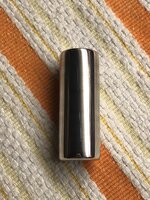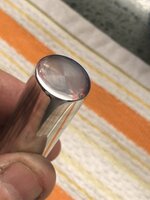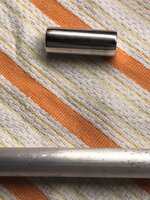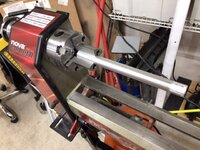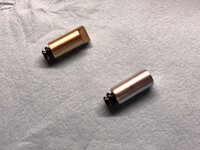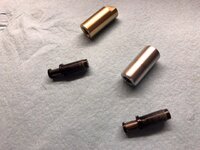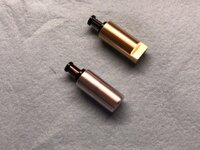Thank you everyone for your replies. I'm sure I'm really going to enjoy this forum as I just got him back into pen turning after many years where I used to have a Shopsmith. I love the Nova Comet II and I'm looking forward to going beyond the 7 mm slimlines that I have made so far. Again, this may not be the right forum for this post but I wanted to share my results of my three-quarter inch turned 6061 aluminum rod.
Again, I'm trying to replicate a part that Lee Valley Sells. They are called "prairie dogs" and they are basically a brass bench dog that hides just under the surface and then with a downward press, the magnetic latch allows the dog to pop up about 3/8 inch. This amount is adjustable with the latch itself. These dogs will work with workbenches that have a table thickness of 2 inches to 2 1/2 inches. Mine happens to be 2-1/4" thick. I originally made blind dog holes approximately 2 inches deep. So in my case, I just drop in the dogs with the plunger against the bottom of the hole and adjust the screw mechanism slightly and they're perfect. If you have through holes, Lee Valley supplies a couple of small steel plates with each pair of dogs. These plates screw in underneath your dog hole and can swing out-of-the-way if not needed.
These are wonderful parts and I will supply the part number below. However, at $15 a dog, I decided if I wanted to have a quantity of them positioned around my workbench, it would be a good life project to turn my own. The little plungers are something that I was able to find online; they are exactly the same and cost about three dollars each. Again I'll put the part number below. I found the 6061 aluminum rod on eBay. The rod is under $2.00 for each dog. And then there's my labor at about $50.00 per dog. Ok, but it is a fun project!
So for those of you interested in reading on I will summarize the results of this project, of which I am quite pleased. This was the first time that I had turned aluminum and I learned a couple of things about it as I did so. I hope you will find this useful.
Turning the 3/4" Rod
In my previous post I mentioned that I have a Nova G3 chuck. A couple of you rightfully suggested that I might get better results with a collet chuck. I plan to obtain a collet chuck perhaps in the near future. However, one thing that I didn't mention is that I have Nova's Pen Plus jaws on my G3 for this project. (Photo attached) Those are great for holding square blanks for drilling pens but they can also hold spigots or round rod up to almost 1" in diameter and up to about 9 to 10 inches long. The jaws did great and I have virtually no run out at the end of the rod. I should mention that the only time that the full rod was chucked up was at the beginning in order to get a nice finish on the entire thing and sand it down just a little bit so it fits smoothly in my dog holes. I was looking for about .745" diameter. For the tailstock, I used a heavy 60° live center which was easier to set into the end of the rod
Sanding and Finishing
My plan is to take the full rod at about 10" and do all my sanding and finishing at that point. I'm also reducing the diameter a little bit so that it fits the dog holes. This is much easier than first cutting up the individual dogs. Based on my experience in finishing the rod I have a couple of tips in case any of you want to work with this kind of aluminum rod in the future. I cut a couple of small pieces to test my finishes.
To get a high gloss finish I used 100, 150, 180 and 220 sandpaper while turning at about 1500 RPM. I then applied Mothers Mag and Aluminum Polish at a pretty low speed and then buffed it out probably at about 1000 RPM or so. If you want a super brilliant finish, use the 2 inch micro mesh sanding pads and go through the entire 9 grits. The mirror finish will be extraordinary. After the micro mesh, I finished it with the Mothers polish. When I was done it looks like highly polished chrome plated steel.
To get a beautiful brushed aluminum finish, I went ahead and used the 100 through 220 grit sandpapers. I then switched to a green Scotch-Brite pad and finished it with a white Scotch-Brite pad. Note that if you want a nice brushed aluminum finish, you don't want to use something like the Mothers polish after the scotch bright pads as that will negate the brushed look and bring it back to a gloss. I actually prefer the brushed aluminum look as it barely shows fingerprints.
Drilling the Holes for Push Latches
First I took my finished rod and cut it up into 1-5/8" long dogs. I happened to use a bandsaw for this but there are other methods. I then chucked these up One at a time in the G3 with its penpal jaws. This works very similar to chucking up a Pen blank prior to cutting a hole through the end of it. I used my nice Jacobs chuck on the tailstock. To start the hole I did use a #4 centering drill with a counter sink. I only drilled in with the small centering tip as I didn't go as far as the counter sink. Then I replaced the center drill with my 10 mm drill. As a matter of fact, the problem I was having that made me write you all in the first place was nonexistent. It turned out that my Festool 10mm drill bit was working just fine. I was working against myself yesterday by turning it at way too high of speed. Today I took my time, used cutting fluid, regularly cleared off aluminum chips and ran the lathe at 300 RPM. It took awhile to get a hole that was almost 1 1/8" deep but it takes a little while to drill aluminum properly. I was very happy with the results. The reason I am using a 10mm drill is because the magnetic push latch is a rather odd size. It is M11 x 1 mm. While this size is not the most common tap out there, I was able to find the correct tap and I'll give its part number below as well.
Tapping the Hole
It was nothing special here. I just took my M11 x 1 mm tap in my tap wrench and carefully began to tap the hole. I left the piece in the G3 chuck so I was tapping horizontally. This actually was a comfortable position. As always with tapping, the first 3 to 4 threads are the critical ones as it sets you in the right direction. Again I took my time, use plenty of cutting fluid and worked my way through. All of this was done manually of course without the lathe on and I locked the indexing head stop. The results were great. I use compressed air and my vacuum to clean up the bench dog after I was done. I wanted to get the inside of the threaded hole perfectly clean because the small plastic threads of the push latch could easily cross thread otherwise. But everything worked fine and the push latch went on exactly as it was supposed to. After tapping I ran through my sandpaper grits and scotch bright pads to sand and polish the two ends of the dog. After obtaining the desired brushed aluminum finish, I screwed in the magnetic push latch and I was done! Note: in the pictures I have supplied the Lee Valley prairie dog is the brass color and has the flat on the end. The aluminum dogs (my version) showed up a little different color than the brushed aluminum that they appear in person. I chose to keep my dogs round.
Parts Used
100, 150, 180, 220 grit sandpapers
Green Scotch Bright Pads
White Scotch Bright Pads
Mothers Mag and Aluminum Polish
#4 centering countersink bit
Anytime Tools 5 Center Drill Countersink Lathe Bit Mill Tooling Set - Power Lathe Accessories - Amazon.com
www.amazon.com
10mm Bosch Cobalt Twist Drill Bits
Drill America M11x1mm HSS Plug Tap
Magnetic Push Latches from Westlund Distributing - $2.96 ea.
Lee Valley Prairie Dogs - $29.95/pair

